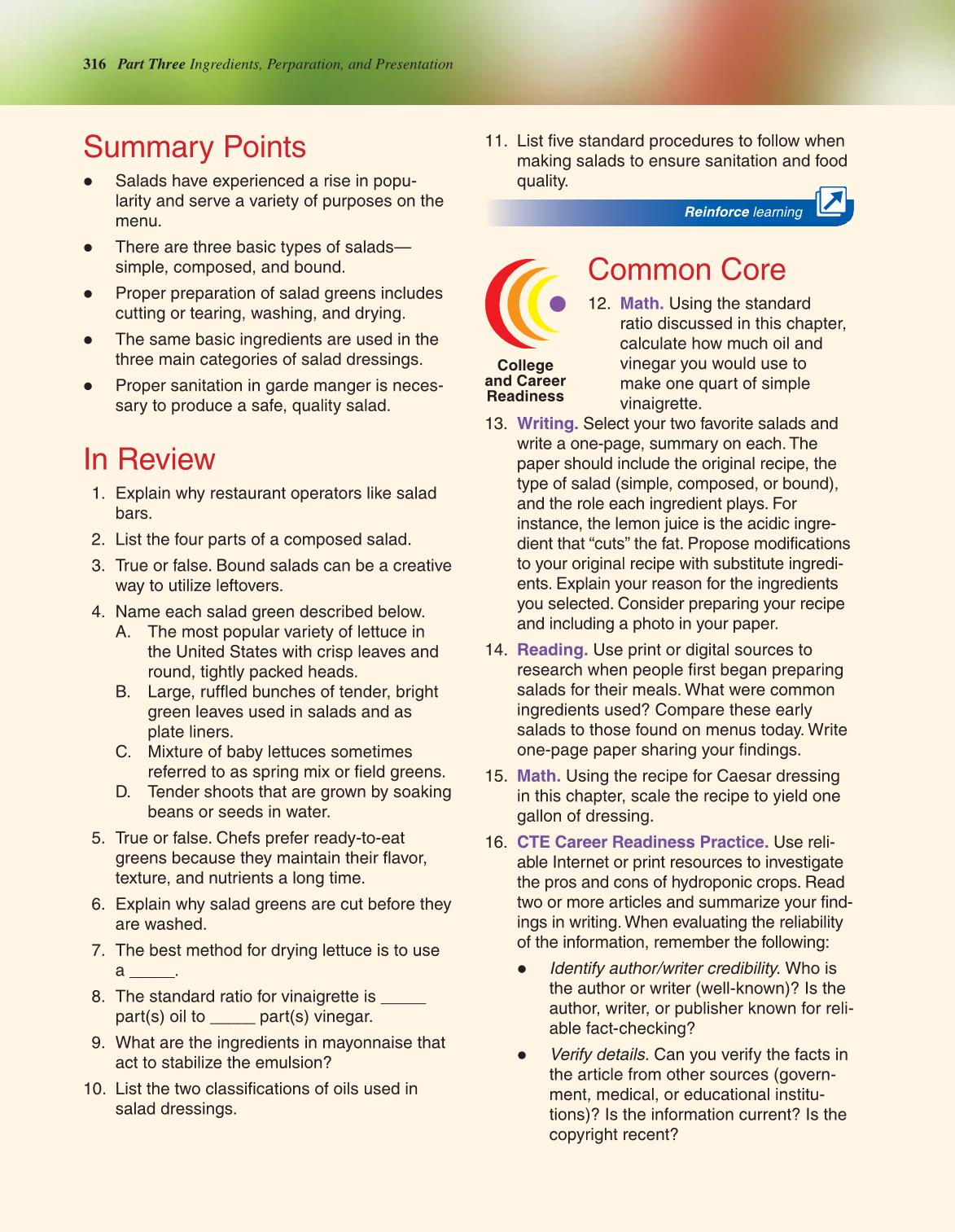316 Part Three Ingredients, Perparation, and Presentation
Summary Points
•
Salads have experienced a rise in popu-
larity and serve a variety of purposes on the
menu.
•
There are three basic types of salads—
simple, composed, and bound.
•
Proper preparation of salad greens includes
cutting or tearing, washing, and drying.
•
The same basic ingredients are used in the
three main categories of salad dressings.
•
Proper sanitation in garde manger is neces-
sary to produce a safe, quality salad.
In Review
1. Explain why restaurant operators like salad
bars.
2. List the four parts of a composed salad.
3. True or false. Bound salads can be a creative
way to utilize leftovers.
4. Name each salad green described below.
A. The most popular variety of lettuce in
the United States with crisp leaves and
round, tightly packed heads.
B. Large, ruffled bunches of tender, bright
green leaves used in salads and as
plate liners.
C. Mixture of baby lettuces sometimes
referred to as spring mix or field greens.
D. Tender shoots that are grown by soaking
beans or seeds in water.
5. True or false. Chefs prefer ready-to-eat
greens because they maintain their flavor,
texture, and nutrients a long time.
6. Explain why salad greens are cut before they
are washed.
7. The best method for drying lettuce is to use
a _____.
8. The standard ratio for vinaigrette is _____
part(s) oil to _____ part(s) vinegar.
9. What are the ingredients in mayonnaise that
act to stabilize the emulsion?
10. List the two classifications of oils used in
salad dressings.
11. List five standard procedures to follow when
making salads to ensure sanitation and food
quality.
Reinforce learning
College
and Career
Readiness
Common Core
12. Math. Using the standard
ratio discussed in this chapter,
calculate how much oil and
vinegar you would use to
make one quart of simple
vinaigrette.
13. Writing. Select your two favorite salads and
write a one-page, summary on each. The
paper should include the original recipe, the
type of salad (simple, composed, or bound),
and the role each ingredient plays. For
instance, the lemon juice is the acidic ingre-
dient that “cuts” the fat. Propose modifications
to your original recipe with substitute ingredi-
ents. Explain your reason for the ingredients
you selected. Consider preparing your recipe
and including a photo in your paper.
14. Reading. Use print or digital sources to
research when people first began preparing
salads for their meals. What were common
ingredients used? Compare these early
salads to those found on menus today. Write
one-page paper sharing your findings.
15. Math. Using the recipe for Caesar dressing
in this chapter, scale the recipe to yield one
gallon of dressing.
16. CTE Career Readiness Practice. Use reli-
able Internet or print resources to investigate
the pros and cons of hydroponic crops. Read
two or more articles and summarize your find-
ings in writing. When evaluating the reliability
of the information, remember the following:
•
Identify author/writer credibility. Who is
the author or writer (well-known)? Is the
author, writer, or publisher known for reli-
able fact-checking?
•
Verify details. Can you verify the facts in
the article from other sources (govern-
ment, medical, or educational institu-
tions)? Is the information current? Is the
copyright recent?
